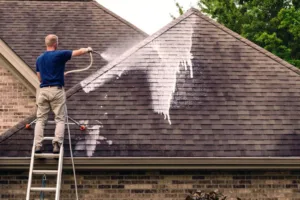Shielding Your Shelter: A Comprehensive Guide to Fortifying Your Roof Against Stormy Skies
Introduction
Roofs are often taken for granted, but they play a vital role in protecting our homes from the wrath of Mother Nature. As storm seasons loom ahead, it becomes imperative to prioritize roof maintenance as part of our storm preparation efforts.
Neglecting this crucial aspect can leave us vulnerable to costly repairs and extensive damage caused by high winds, heavy rains, and hailstorms. By investing time and effort into proper roof maintenance, we can fortify our homes against these natural forces and ensure the safety of our loved ones.
The Importance of Roof Maintenance in Storm Preparation
In order to comprehend the significance of roof maintenance in storm preparation, it is necessary to understand how storms can wreak havoc on our roofs. High winds have the potential to lift shingles or even tear them off completely.
The forceful impact of hailstones can cause dents, punctures, or cracks in roofing materials. Additionally, heavy rainfall may lead to water pooling or leakage if there are any vulnerabilities in the roofing system.
By maintaining your roof regularly and ensuring its structural integrity before a storm hits, you minimize the risk of extensive damage or complete failure during severe weather events. Properly maintained roofs offer better resistance against wind uplift pressures and prevent water intrusion that could result in costly interior repairs caused by leaks or mold growth.
Overview of Essential Roof Maintenance Tips
When it comes to preparing your roof for storm season, following essential maintenance tips is paramount:
Schedule Regular Professional Inspections:
A biannual inspection conducted by a professional roofing contractor is highly recommended to identify any potential issues that might compromise your roof’s performance during storms. These experts have an eye for detail and possess extensive knowledge about common vulnerabilities specific to various roofing materials. They will thoroughly examine your roof and provide a comprehensive assessment, allowing you to address any concerns promptly.
Perform DIY Inspections:
In addition to professional inspections, homeowners should conduct periodic visual inspections themselves. Look for loose or damaged shingles that might need repair or replacement.
Check for signs of water leaks or moisture intrusion in your attic or ceilings. Taking note of these issues early on can prevent further damage and inform your decisions regarding necessary repairs.
Clear Debris and Maintain Gutters:
Regularly removing debris from your roof’s surface is essential to prevent clogged gutters and water pooling during storms. Fallen leaves, branches, and other organic matter can accumulate, obstructing proper drainage.
It is crucial to exercise caution when removing debris to avoid damaging the shingles in the process. Maintaining clean gutters is equally important as they direct rainwater away from your home’s foundation.
Remove leaves, twigs, and any other debris that may have collected in the gutters. Regular gutter cleaning ensures they are functioning optimally, preventing potential water damage that could seep into your home during heavy rainfall.
Understanding the Roofing System
Different types of roofing materials and their vulnerabilities to storms
When it comes to protecting your home from storm damage, understanding the various types of roofing materials is essential. Each material has its strengths and vulnerabilities when it comes to withstanding severe weather conditions.
For instance, asphalt shingles, which are commonly used due to their affordability, can be prone to wind uplift and damage from hailstorms. Metal roofs, on the other hand, offer superior durability against high winds and hail but may dent under extremely severe conditions.
Slate and tile roofs provide excellent resistance to fire and wind but can crack if hit by heavy debris during storms. By knowing the characteristics of your specific roofing material, you can anticipate potential weaknesses and take appropriate preventive measures.
Components of a roofing system: shingles, underlayment, flashing, gutters, etc.
A roofing system consists of various components that work together to protect your home from storm damage. Understanding these components is crucial in ensuring your roof’s resilience during severe weather events. The primary component is the shingles or outer layer that shields your roof from rainwater and impacts.
Underneath the shingles lies an underlayment – typically a waterproof membrane or felt paper – which provides an additional layer of protection against water intrusion. Flashings are another vital element in safeguarding against storm damage.
Installed around joints and valleys in roofs, flashings prevent water from seeping into vulnerable areas such as chimneys or skylights. Additionally, gutters play a critical role in directing rainwater away from the roof’s surface and foundation walls.
How each component plays a crucial role in protecting against storm damage
Each component within a roofing system plays a vital role in fortifying your home against storm-induced harm. The shingles act as a first line of defense by enduring the impact of wind, rain, and debris.
The underlayment provides an extra layer of waterproofing, protecting the roof deck from moisture intrusion. Flashings seal vulnerable areas and prevent water leaks into your home’s interior.
Properly functioning gutters and downspouts efficiently channel water away from the roof’s surface and foundation, preventing pooling or erosion. The combined efforts of these components create a robust roofing system that can withstand the challenges presented by storms.
Maintaining each element in good condition is essential to ensure their effectiveness in protecting your home against severe weather events. Regular inspections, timely repairs, and proactive maintenance will go a long way in preserving the integrity of your roofing system and safeguarding your property from storm-related damage.
Regular Inspections and Maintenance
The Importance of Regular Roof Inspections by Professionals
Roofs are constantly exposed to the harsh elements and undergo significant wear and tear over time. This makes regular inspections by professionals a vital aspect of roof maintenance, especially when preparing for storm season.
Professional roofers possess the expertise to identify even the most subtle signs of damage that may go unnoticed by homeowners. By bringing in a professional inspector, you can ensure that your roof is thoroughly examined, helping to detect any underlying issues before they worsen.
Frequency: Biannually or After Severe Weather Events
To maintain the integrity of your roof, it is recommended to schedule professional inspections at least twice a year. However, in regions prone to severe weather conditions like heavy rainfall or hailstorms, it is wise to have your roof inspected soon after such events occur. These inspections help identify any storm-related damage that could compromise the stability and functionality of your roofing system.
Benefits: Early Detection of Issues, Prevention of Major Damage
Regular professional inspections provide numerous benefits for homeowners. Perhaps the most crucial advantage is early detection and prevention of potential issues. Professional inspectors can identify loose or damaged shingles, deteriorating flashing, weakened underlayment, or any other signs indicating potential problems before they escalate into costly repairs or complete roof replacements.
By addressing minor damages promptly through regular maintenance, you can prevent larger problems from arising down the line. This proactive approach also extends the lifespan of your roof while ensuring its ability to withstand upcoming storms with greater resilience.
DIY Inspections for Homeowners
Identifying Loose or Damaged Shingles
While professional inspections are highly recommended for thorough assessments, homeowners can also perform their own visual inspections periodically. Begin by safely accessing an elevated vantage point where you can view your roof from different angles.
Look out for any signs of loose or missing shingles, which may be visible as gaps or irregularities in the roofing material. These damaged shingles can compromise the waterproofing integrity of your roof and expose it to potential leaks during storms.
Checking for Signs of Water Leaks or Moisture Intrusion
Another critical aspect of DIY inspections is evaluating signs of water leaks or moisture intrusion. Start by examining your ceiling and walls inside the house for any discoloration, water stains, or peeling paint – these are often indicative of water damage caused by a compromised roof.
Additionally, inspecting the attic during daylight hours allows you to look for any light seepage through cracks or gaps where it should not be present. Furthermore, pay attention to any musty odors emanating from the attic or other areas near the roof, as this may suggest excess moisture buildup due to a faulty roofing system.
Identifying these warning signs early on enables you to take appropriate actions promptly and seek professional assistance if necessary. Regular inspections and maintenance, both by professionals and homeowners themselves, form an integral part of storm preparedness when it comes to maintaining a robust and resilient roof.
By investing time and effort into routine checks, you can ensure that your roofing system remains in prime condition throughout storm season while minimizing potential damage risks. Remember, early detection is key in preventing minor issues from escalating into major problems that could have far-reaching consequences for both your home’s structural integrity and your financial well-being.
Clearing Debris and Maintaining Gutters
Removing debris from the roof surface:
One of the essential aspects of proper roof maintenance is regularly clearing debris from the roof surface. Fallen leaves, branches, and other organic matter can accumulate over time, creating a potential hazard for your roofing system.
Not only can these debris clog gutters, impeding the proper flow of rainwater, but they can also trap moisture against the roof’s surface. This trapped moisture can lead to rotting, mold growth, and even structural damage if left unaddressed.
When removing debris from your roof surface, it is crucial to exercise caution to avoid causing any damage to shingles or other roofing components. Start by using a sturdy ladder positioned securely on level ground.
Carefully remove larger items like branches by hand or with the help of a rake or broom designed for this purpose. For smaller debris like leaves and twigs, a leaf blower or gentle sweeping with a soft-bristle brush can be effective in clearing them away without harming the shingles.
Cleaning and maintaining gutters:
In addition to removing debris from the roof surface itself, regular cleaning and maintenance of gutters are imperative for an efficiently functioning roofing system. Clogged gutters prevent water from properly draining off your roof during storms, resulting in water pooling along the edges or seeping into your home’s foundation. To clean your gutters effectively, start by wearing protective gloves and using a sturdy ladder placed securely against your home.
Begin at one end of the gutter system and work your way down while carefully removing any leaves, twigs, dirt buildup, or other obstructions by hand or with a small garden trowel. Once you have cleared as much debris as possible manually, use a hose to flush out remaining residue thoroughly.
Conclusion
Taking the time to clear debris from your roof surface and maintain your gutters is a vital component of successful roof maintenance, particularly when preparing for storm seasons. By removing fallen leaves, branches, and other organic matter promptly, you can prevent clogged gutters and water pooling that may lead to costly damage or leaks within your home. Moreover, cleaning and maintaining gutters help ensure the proper flow of rainwater away from your roof, protecting its longevity and structural integrity.
By implementing these essential roof maintenance practices, you are actively fortifying your home against potential storm damage. Remember that small actions can have significant impacts on the overall health of your roofing system.
So, embrace these tasks as an opportunity to safeguard one of the most valuable investments you have made – your home. With regular attention and maintenance, you can weather any storm with confidence knowing that your roof stands strong above you.







